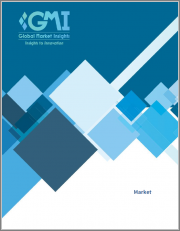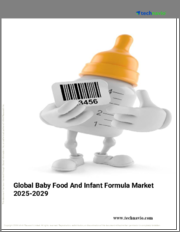
|
시장보고서
상품코드
1359573
유아용 조제분유 성분 시장 규모 : 유형별, 공급원별, 유통 채널별 및 세계 예측(2023-2032년)Infant Formula Ingredients Market Size-By Type (Carbohydrates, Proteins, Fats, Vitamins & Minerals, Nucleotides), By Source (Dairy-Based Ingredients, Plant-Based Ingredients, Synthetic Ingredients), Distribution Channel & Global Forecast, 2023-2032 |
||||||
유아용 조제분유 성분 시장 규모는 영유아 영양의 중요성에 대한 부모들의 인식이 높아지면서 2023년부터 2032년까지 연평균 8.5%의 성장률을 보일 것으로 예상됩니다.
맞벌이 부부의 증가로 편리하고 영양이 균형 잡힌 유아용 조제분유에 대한 수요가 증가하고 있습니다. 또한, 신흥국의 가처분 소득 수준이 급증하면서 고급 유아용 조제분유에 대한 지출이 증가하여 시장 성장을 더욱 촉진하고 있습니다.
단백질 공급원 및 가공 기술 혁신을 포함한 유아용 조제분유 성분의 발전은 유아용 조제분유 제품의 영양 성분과 안전성을 향상시켜 소비자의 신뢰를 높이고 있습니다. 예를 들어, 2023년 5월 Arla Food Ingredients는 알파-락토알부민을 풍부하게 함유한 새로운 유아용 조제분유 성분을 출시했습니다. 고단백질 함유는 유아의 체중 증가를 촉진할 것으로 알려져 있어 저단백질 조제분유에 대한 수요 증가에 대응할 수 있을 것으로 기대됩니다. 이러한 제품 개발은 향후 몇 년 동안 시장 성장에 영향을 미칠 것으로 예상됩니다.
유아용 조제분유 성분 시장은 유형, 공급원, 유통 채널, 지역별로 세분화됩니다.
비타민 및 미네랄 유형은 유아의 건강한 성장과 발달에 필수적인 성분이기 때문에 2032년까지 상당한 수익을 창출할 것으로 예상됩니다. 비타민 A, D, E, K와 같은 주요 비타민은 유아용 조제분유에 필수적인 성분입니다. 이들은 뼈 건강, 시력 발달 및 전반적인 면역 기능을 지원합니다. 부모들이 자녀의 건강에 대한 관심이 높아짐에 따라 이러한 비타민이 강화된 유아용 조제분유에 대한 수요가 증가하고 있습니다. 시장 업체들은 진화하는 유아의 영양 요구를 충족하는 비타민 강화 조제분유를 제공하기 위해 끊임없는 혁신을 거듭하고 있습니다.
식물성 원료 부문은 2032년까지 크게 성장할 것으로 예상됩니다. 콩, 쌀, 귀리와 같은 식물성 원료는 유아를 위한 비건 및 채식주의자 선택을 선호하는 부모들 사이에서 인기를 끌고 있습니다. 이러한 원료는 지속가능하고 윤리적이며 환경에 미치는 영향과 동물복지에 대한 우려를 해소할 수 있는 선택지를 제공합니다. 충분한 영양을 공급하고 부모가 기대하는 고품질 조제분유를 생산하기 위한 R&D 투자 증가는 이 분야의 성장을 촉진할 것으로 보입니다.
아시아태평양의 유아용 조제분유 성분 산업은 중국, 인도, 동남아시아 국가들의 급속한 도시화, 출산율 증가, 가처분 소득 증가로 인해 2032년까지 유리한 기회를 창출할 것으로 예상됩니다. 유아 조제분유에 대한 수요 증가는 유아 영양에 대한 인식이 높아지고 아시아태평양 국가들의 서유럽식 식습관 채택이 기여하고 있습니다. 이에 따라 제조업체들은 이 성장 시장에 대응하기 위해 아시아태평양에서의 입지와 생산 시설을 확대하는 데 주력하고 있습니다.
목차
제1장 조사 방법과 조사 범위
제2장 주요 요약
제3장 유아용 조제분유 성분, 산업 인사이트
- 생태계 분석
- 업계에 대한 영향요인
- 성장 촉진요인
- 업계의 잠재적 리스크와 과제
- 성장 가능성 분석
- COVID-19의 영향 분석
- 규제 상황
- 미국
- 유럽
- 가격 분석, 2022년
- 기술 전망
- 향후 시장 동향
- Porters 분석
- PESTEL 분석
- 러시아·우크라이나 전쟁의 영향
제4장 경쟁 상황
- 서론
- 기업 매트릭스 분석
- 세계 기업 점유율 분석
- 경쟁 포지셔닝 매트릭스
- 전략 대시보드
제5장 유아용 조제분유 성분 시장 규모와 예측 : 유형별 2018-2032년
- 탄수화물
- 단백질
- 지방
- 비타민·미네랄
- 뉴클레오티드
- 기타
제6장 유아용 조제분유 성분 시장 규모와 예측 : 공급원별 2018-2032년
- 유제품 유래 성분
- 식물 유래 성분
- 합성 성분
제7장 유아용 조제분유 성분 시장 규모와 예측 : 유통 채널별 2018-2032년
- 슈퍼마켓 및 하이퍼마켓
- 약국·드럭스토어
- 온라인 소매
- 기타
제8장 유아용 조제분유 성분 시장 규모와 예측 : 지역별 2018-2032년
- 주요 동향 : 지역별
- 북미
- 미국
- 캐나다
- 유럽
- 독일
- 영국
- 프랑스
- 스페인
- 이탈리아
- 아시아태평양
- 일본
- 중국
- 인도
- 호주
- 한국
- 인도네시아
- 말레이시아
- 라틴아메리카
- 브라질
- 멕시코
- 아르헨티나
- MEA
- 남아프리카공화국
- 사우디아라비아
- 아랍에미리트
- 이집트
제9장 기업 개요
- DuPont de Nemours, Inc.
- Koninklijke DSM N.V.(DSM)
- Arla Foods Ingredients Group P/S
- FrieslandCampina Ingredients
- Kerry Group plc
- BASF SE
- Ingredion Incorporated
- Glanbia plc
- AAK AB
- Chr. Hansen Holding A/S
- Saputo Inc.
- Carbery Group Ltd.
- Tate & Lyle plc
- Lonza Group AG
- Archer Daniels Midland Company
Infant formula ingredients market size is expected to record 8.5% CAGR from 2023 to 2032 driven by the rising awareness among parents about the importance of infant nutrition. With the increasing number of working parents, there is a growing demand for convenient and nutritionally balanced infant formula options. Additionally, a surge in disposable income levels in emerging economies has resulted in higher spending on premium infant formula products, further fueling market growth.
The advancements in infant formula ingredients, including innovations in protein sources and processing techniques, are enhancing the nutritional content and safety of infant formula products, boosting consumer confidence. For instance, in May 2023, Arla Food Ingredients launched a new infant formula ingredient rich in alpha-lactalbumin. This is expected to meet the rising need for low-protein formulations, as high protein contents are said to drive weight gain in infants. Such product developments are expected to influence market growth in the coming years.
Infant formula ingredients market is divided based on type, source, distribution channel, and region.
The vitamins & minerals type segment is expected to generate substantial revenues through 2032 as they are essential for the healthy growth and development of infants. Key vitamins such as vitamin A, D, E, and K are integral components of infant formula. They support bone health, vision development, and overall immune function. As parents become more conscious of their child's well-being, the demand for infant formulas fortified with these vitamins is on the rise. Market players are continuously innovating to provide vitamin-enriched infant formula options that meet the evolving nutritional requirements of infants.
The plant-based segment is predicted to witness significant growth through 2032. Plant-based ingredients, such as soy, rice, and oat, are gaining popularity among parents who prefer vegan or vegetarian options for their infants. These ingredients offer a sustainable and ethical choice, addressing concerns about environmental impact and animal welfare. The increased investments in R&D to create plant-based infant formulas that provide adequate nutrition and maintain the high-quality standards expected by parents, will stimulate the segment growth.
Asia Pacific infant formula ingredients industry is predicted to generate lucrative opportunities through 2032 due to rapid urbanization, increasing birth rates, and rising disposable incomes in countries like China, India, and Southeast Asian nations. The growing awareness about infant nutrition and the adoption of Western dietary patterns in the APAC countries are contributing to the increased demand for infant formula products. As a result, manufacturers are focusing on expanding their presence and production facilities in the Asia Pacific region to cater to this growing market.
Table of Contents
Chapter 1 Methodology & Scope
- 1.1 Industry coverage
- 1.2 Market scope & definition
- 1.3 Base estimates & calculations
- 1.3.1 Data collection
- 1.4 Forecast parameters
- 1.5 COVID-19 impact analysis at global level
- 1.6 Data validation
- 1.7 Data Sources
- 1.7.1 Primary
- 1.7.2 Secondary
- 1.7.2.1 Paid sources
- 1.7.2.2 Unpaid sources
Chapter 2 Executive Summary
- 2.1 Infant formula ingredients industry 360 degree synopsis, 2018 - 2032
- 2.2 Business trends
- 2.3 Type trends
- 2.4 Source trends
- 2.5 Distribution Channel trends
- 2.6 Regional trends
Chapter 3 Infant formula ingredients Industry Insights
- 3.1 Industry ecosystem analysis
- 3.2 Industry impact forces
- 3.2.1 Growth drivers
- 3.2.2 Industry pitfalls & challenges
- 3.3 Growth potential analysis
- 3.3.1 By type
- 3.3.2 By source
- 3.3.3 By distribution channel
- 3.4 COVID- 19 impact analysis
- 3.5 Regulatory landscape
- 3.5.1 U.S.
- 3.5.2 Europe
- 3.6 Pricing analysis, 2022
- 3.7 Technology landscape
- 3.7.1 Future market trends
- 3.8 Porter's analysis
- 3.9 PESTEL analysis
- 3.10 Impact of Russia Ukraine war
Chapter 4 Competitive Landscape, 2022
- 4.1 Introduction
- 4.2 Company matrix analysis, 2022
- 4.3 Global company market share analysis, 2022
- 4.4 Competitive positioning matrix
- 4.5 Strategy dashboard
Chapter 5 Infant Formula Ingredients Market Size and Forecast, By Type 2018 - 2032
- 5.1 Carbohydrates
- 5.2 Proteins
- 5.3 Fats
- 5.4 Vitamins & Minerals
- 5.5 Nucleotides
- 5.6 Others
Chapter 6 Infant Formula Ingredients Market Size and Forecast, By Source 2018 - 2032
- 6.1 Dairy-Based Ingredients
- 6.2 Plant-Based Ingredients
- 6.3 Synthetic Ingredients
Chapter 7 Infant Formula Ingredients Market Size and Forecast, By Distribution Channel 2018 - 2032
- 7.1 Supermarkets & Hypermarkets
- 7.2 Pharmacies & Drugstores
- 7.3 Online Retail
- 7.4 Others
Chapter 8 Infant Formula Ingredients Market Size and Forecast, By Region 2018 - 2032
- 8.1 Key trends, by region
- 8.2 North America
- 8.2.1 U.S.
- 8.2.2 Canada
- 8.3 Europe
- 8.3.1 Germany
- 8.3.2 UK
- 8.3.3 France
- 8.3.4 Spain
- 8.3.5 Italy
- 8.4 Asia Pacific
- 8.4.1 Japan
- 8.4.2 China
- 8.4.3 India
- 8.4.4 Australia
- 8.4.5 South Korea
- 8.4.6 Indonesia
- 8.4.7 Malaysia
- 8.5 Latin America
- 8.5.1 Brazil
- 8.5.2 Mexico
- 8.5.3 Argentina
- 8.6 MEA
- 8.6.1 South Africa
- 8.6.2 Saudi Arabia
- 8.6.3 UAE
- 8.6.4 Egypt
Chapter 9 Company Profiles
- 9.1 DuPont de Nemours, Inc.
- 9.2 Koninklijke DSM N.V. (DSM)
- 9.3 Arla Foods Ingredients Group P/S
- 9.4 FrieslandCampina Ingredients
- 9.5 Kerry Group plc
- 9.6 BASF SE
- 9.7 Ingredion Incorporated
- 9.8 Glanbia plc
- 9.9 AAK AB
- 9.10 Chr. Hansen Holding A/S
- 9.11 Saputo Inc.
- 9.12 Carbery Group Ltd.
- 9.13 Tate & Lyle plc
- 9.14 Lonza Group AG
- 9.15 Archer Daniels Midland Company



















